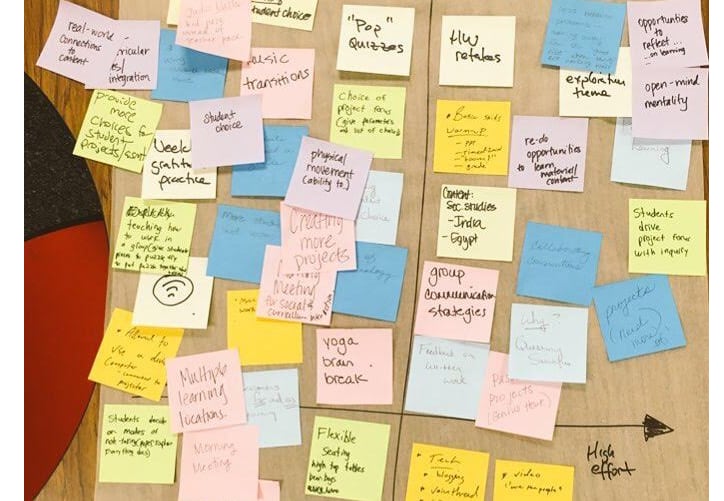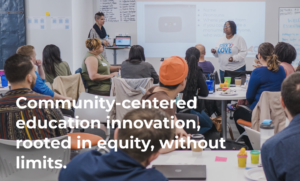Using UX Principles for Designing Curriculum

This year marked the 30th anniversary of the Challenger Explosion, and all over social media people shared their memories the event. In fact, most people remembered exactly where they were and what they were doing at the time of the explosion, given that the memory of the day were seared into our minds. Though only in second grade, I remember Mrs. Dudley turning on the tv, while we watched the news coverage together in a silent, dark room (I happened to be sitting on the left side of the room, near the tv). Likewise, just about anyone who was living in this country at the time can tell you what they were doing on September 11, 2001 or November 22, 1963, on account of the the intense emotional experience of these tragic events that the entire country felt.
We now understand that memory is largely shaped by emotion, whether good or bad, as much as by anything else. The hippocampus, which is responsible for creating our memories, is also directly involved in processing emotion, and so on a neurological level, memory and emotion are closely linked, on account of the role that emotion plays in focusing our attention (see John Medina’s Brain Rules). In other words, experiences that activate emotional responses are more likely to be stored in our long-term memory by the hippocampus.
Knowing this, how might we use emotion to create more effective learning experiences in schools? It turns out that user experience designers may be able to help us learn how to use emotion more effectively in our classrooms.
User experience design (UX Design or UXD) has quickly become one of the more important areas of focus in the startup world, with UX jobs in no short supply. According to Luke Miller, author of The Practitioner’s Guide to User Experience Design and a design researcher who teaches UXD for General Assembly, UX design is “designing to serve the needs of others” (p. 19). Miller describes the main ideas of UX design using the “LEMErS” acronym, first shared by Jakob Nielsen, co-founder of the Nielsen Norman Group:
- Learnability → How easy is it to accomplish basic tasks for the first time?
- Efficiency → Once learned, how quickly can one perform tasks?
- Memorability → How easy can one reestablish proficiency after time away?
- ERrors → How often are errors made and how are they handled?
- Satisfaction → How pleasant is it to use the design?
When creating, for example, a new app, designers keep these ideas in mind to ensure that users have a positive an experience as possible, lest they never return to the app. In considering the LEMErS principles, interface designers have learned to make use of swipe gestures in mobile apps. Not originally a feature of smartphones, swipe gestures now comprise some of the most common and essential features of mobile apps, with designers taking advantage of their ease and familiarity to enable us to complete a wide variety of tasks using only our thumbs. Tinder, in fact, now reports 1.4 billion swipes per day!
Most of our curriculum development in schools targets content, including what focus areas to cover and writing assessments for these focus areas. When I first began teaching Latin at the middle-school level, curriculum design, to my mind, primarily involved pacing out content over the course of the academic year. I believed that, because I had passion for the Latin language and Roman culture, so would the majority of my students. In other words, I simply assumed that experience follows curriculum and that, if I have fun with Latin, so will everyone else. In making this assumption, I violated the most basic principle of design, namely, that my design choices should serve the needs of my students, which are very different from my own.
To help us better understand our users, Miller and other UX designers rely on user profiles to give them a better idea of how their users might interact with their design work.
For educators, we can create similar student profiles summarizing who our students are so we can better understand how our students are interacting with our course content.
For example, we might have Janie in our class, a 12-year-old 7th grader who, in addition to Latin, has six other classes a day. She gets up at 6:30am to be on a bus by 7am, which takes at least 45 minutes to get to campus, thanks to Los Angeles traffic. She barely has time to eat breakfast, before starting classes, and most of her classes involve sitting in her chair while her teachers lead her through course material. She has 30 minutes for lunch, in between meeting with teachers and taking care of other tasks. After classes end at 3pm, she stays on campus until at least 5pm to practice lacrosse or do homework (in the offseason), and so she rarely gets home before 6pm. When she does get home, she has family obligations until around 8pm, at which time she finally starts her homework. Janie repeats this day as much as 180 times over the course of the year.
With this in mind, it’s now more clear to me that Janie will seldom be interested in my lectures, regardless of how many engagement strategies I use, including my best jokes. Instead, she’s more interested in chatting with her friends, who she seldom has extended time to chat with during the course of the day. Because she’s not engaged as fully as she could be, there’s little chance of her truly learning the material I’m covering in class, and homework, no matter how interesting, is going to spark her interest, when she’s stuck doing it at 9pm. To help her learn Latin as well as she can, I need more than the right course pacing and lively course lectures.
Just as UX designers design apps to be easy and pleasing to use, we can design our course experiences in ways that facilitate student learning most effectively using the “LEMErS” principles outlined above. Many educators are already doing this through the use of technology, collaborative space, and student-centered practices like “genius hour” and project-based learning. We, of course, want our curriculum to be learnable without taking too much effort, and we certainly want our students to remember what they’ve learned long after our courses end.
But I think we still have some work to do in understanding who our students are and discovering how to engage and motivate them in more meaningful ways, and this is where UX design may have something to teach us.
Using UX design principles within a set of principles that govern what we can call “curriculum experience design,” we can try to build our curricula around the experiences that students have in our courses.
Most critically, it is more apparent than ever that we should build our curricula around story, which is one of the central tenets of good UX design. “The key [i.e., to great design],” Miller says (p. 73), “is thinking of yourself as a storyteller and designing with all the complexity and richness of human emotion in mind.” In this way, machines designed to interact with people are taking on more human-like features to improve the overall quality of the interactions (think Siri, for example).
Given the power that story has to affect our attitudes and rouse an emotional response, as neuroeconomist Paul Zak has argued, we have every reason to take advantage of storytelling as a learning tool. By first understanding our students as “users” of our curricula through the profiles we should build for them, we can then consider how create the kinds of experiences that allow them to learn most efficiently and effectively. When writing curriculum, we can consider the following questions:
- What story does your course content tell?
- How does the course tell its story and drive emotions like excitement and surprise?
- What role do our students have in telling or even creating the story?
Curriculum, then, becomes more than a assemblage of content topics and a calendar of dates for assessments: in other words, it’s more than a collection of dots.
A compelling story helps us to connect the dots together within a narrative that, when done well, can help students to build an emotional connection to our course content, thereby helping them to learn it better.
And by taking an active role within the story, we can build stronger empathetic connections to other characters in the story, in the process learning more effectively not only our course content but also critical social and emotional skills.
In mu Latin courses, for example, the exploration of Roman culture moves us through grammatical content (see more details here), while telling the story of how Romans interacted with each other. We view grammar vocabulary as a growing and evolving organism, using what we know to help make connections to new material, while project work challenges us to build a story around personas we create through investigation of geography, mythology, physical space, culture codes, and more.
Our story has a beginning in September, when we “onboard” our students by setting the background and establishing the rules of our world, before moving into a middle and a conclusion. It’s critical that what we’re doing in the middle of our story necessarily depends on what we did earlier in the story and likewise sets the stage for the conclusion of the story at the end of the course. Similarly, I can see how science courses can tell the story of inquiry and understanding, English the story of ideas and communication, and history the story of people and our motivations.
At a recent conference in a discussion about teaching the humanities, a English teacher lamented that he’s been having difficulties teaching literature because he wants his students to have the same experience that he had when he was first introduced to the field. Though his intentions were nothing but noble and honest, his approach is unfortunately doomed to failure, since we shouldn’t expect our students to react to our course content and fall in love with it in the same ways we may have on first encounter. As our sample user profile of 7th-grade Janie above shows us, students may be in very different places from us for a number of reasons. Consequently, when designing curricula, just as when designing a new mobile app to be learnable and efficient in use, we can let our content tell a story and lead our students through it as participants or, even better, as authors.
Engaging stories gives students opportunities to connect with course content in their own ways and takes advantage of the way the brain uses emotion in creating lasting memories. And as story helps us to focus our attention, it will also help us to learn more effectively.
I’d love to learn more about the ideas that others have for curriculum experience design and creating a story within their courses, so please feel free to share ideas in the comments below. Let’s work to “change the UX of schools,” as Dominic Randolph, Head of School at Riverdale Country School in New York, has urged:
“We need to change the UX of schools.” — @daar17 https://t.co/IRpU8ulWCu #reimaginePD #dtk12chat #caedchat #isedchat pic.twitter.com/XgJm5goCua
— Moss Pike (@mosspike) December 18, 2015
In addition to Luke Miller’s The Practitioner’s Guide to User Experience Design, some other great books on UX design include the following titles:
- 100 Things Every Designer Needs to Know About People
- Don’t Make Me Think, Revisited: A Common Sense Approach to Web Usability
- Lean UX: Applying Lean Principles to Improve User Experience
- Usable Usability: Simple Steps for Making Stuff Better
- The User Experience Team of One: A Research and Design Survival Guide
And see General Assembly’s list of the top blogs by UX designers.
For more blogs by Moss, check out:
- “Moneyballing” Grades: Using Sabermetrics to Improve Feedback
- Time for an Honest Conversation About Confronting Change
- Using Exploratory Projects, Minecraft and Storytelling for Personalized World Language Learning
Stay in-the-know with all things EdTech and innovations in learning by signing up to receive the weekly Smart Update.






0 Comments
Leave a Comment
Your email address will not be published. All fields are required.